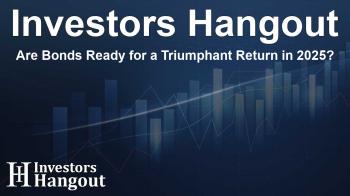Are Bonds Ready for a Triumphant Return in 2025?

The Potential Renaissance of Bonds
As we navigate through the complex landscape of financial investments post-pandemic, the conversation around bonds is gaining momentum. After a challenging stretch where bonds, especially U.S. Treasuries, have struggled significantly, there’s an argument brewing that 2025 might just be the year that bonds reclaim some of their lost glory. This discussion is becoming increasingly relevant as the dynamics of interest rates and economic growth evolve.
Understanding Recent Performance Trends
For a couple of years now, fixed income assets have experienced notable underperformance. Particularly in 2022, when central banks raised interest rates to combat soaring inflation following the pandemic and geopolitical tensions, bonds faced a significant downturn. Notably, the last time U.S. Treasury bonds enjoyed double-digit gains was back in 2008, with a strong 14% return recorded that year by the ICE BofA U.S. Government Bond Index. In the interim years of 2023 and 2024, returns have been more modest, and corporate bonds notably outperformed them, yet both fell short in comparison to the S&P 500's impressive returns of 24% and 23% respectively.
Can Bonds Compete with Stocks?
Despite the current narrative projecting bonds as less favorable when interest rates are elevated, it’s essential to look beyond the surface. Wall Street hasn’t only survived but thrived in this environment, largely experiencing growth thanks to robust U.S. economic performance, underscored by advances in artificial intelligence. However, the performance of bonds has caused many investors to question their viability, sparking concerns about the ongoing U.S. borrowing and spending trends.
The High Yields Landscape
Chris Iggo, chair of the AXA IM Investment Institute, presents a counter-narrative. Analyzing data over the last 40 years suggests current bond yields could herald positive total returns within the subsequent year. Historical data indicates that the Bloomberg Aggregate U.S. Government Bond Index has shown positive monthly returns 90% of the time when yields have reached 4.6% or higher since 1985. It’s a compelling argument that challenges the prevailing fears.
A Historical Perspective
Historically, in the decade leading up to the Global Financial Crisis, interest rates were significantly higher, with the 10-year treasury yield oscillating between 4% and 7%. During that time, the ICE BofA U.S. Government Bond Index witnessed substantial recovery and growth, generating positive returns almost every year, even as the S&P 500 encountered several tumultuous periods of decline.
The Current Investment Climate
Fast forward to the present day, the era of low interest rates seems to have concluded. Yet, investors shouldn't let fear dictate their bond strategies. Current market conditions present abundant liquidity coupled with a low default risk environment. Furthermore, there’s a heightened demand for bonds, evidenced by the recent record-breaking demand during French and Spanish debt auctions.
Investor Sentiment
The appetite for bonds remains steadfast. According to records, U.S. bond funds attracted a staggering $435 billion last year, a trend that could see continuation in the upcoming periods, spurred by solid global interest in U.S. fixed income securities and appealing yields, alongside expectations of a soft landing for the U.S. economy.
Valuation Insights
Analysts are echoing sentiments that in comparison to equities, many bonds currently appear undervalued. A recent analysis indicated that the selloff in U.S. Treasuries ranks high historically, suggesting a buying opportunity. Furthermore, the equity risk premium—the difference between the earnings yield of the S&P 500 and the 10-year Treasury yield—is at its lowest in 25 years, with some evaluations indicating it might be negative, highlighting an appealing entry point for bond investors.
Future Outlook
While skepticism among investors remains high due to the tumultuous journey over the past two years, it is essential to remember that every market cycle brings renewed opportunities. The bonds' narrative may just be shifting, encouraging discussions that 2025 could indeed turn into a pivotal year for bonds.
Frequently Asked Questions
What factors are influencing bond performance currently?
Factors impacting bond performance include interest rate hikes, inflation, and overall economic growth, along with geopolitical events that affect global markets.
Why have bonds struggled in recent years?
Bonds have struggled due to rising interest rates aimed at combating inflation, which has dampened their performance compared to stocks.
What is the outlook for bonds in 2025?
Some analysts believe that 2025 could be a significant year for bonds as market conditions and investor sentiment evolve positively.
Are bonds still a safe investment?
While bond investment carries risks, current market conditions indicate lower default risks, and many believe they still offer attractive income potential.
How do current yields compare historically?
Current yields are competitive compared to historical norms, suggesting potential for positive returns moving forward, consistent with past trends when yields were at similar levels.
About Investors Hangout
Investors Hangout is a leading online stock forum for financial discussion and learning, offering a wide range of free tools and resources. It draws in traders of all levels, who exchange market knowledge, investigate trading tactics, and keep an eye on industry developments in real time. Featuring financial articles, stock message boards, quotes, charts, company profiles, and live news updates. Through cooperative learning and a wealth of informational resources, it helps users from novices creating their first portfolios to experts honing their techniques. Join Investors Hangout today: https://investorshangout.com/
Disclaimer: The content of this article is solely for general informational purposes only; it does not represent legal, financial, or investment advice. Investors Hangout does not offer financial advice; the author is not a licensed financial advisor. Consult a qualified advisor before making any financial or investment decisions based on this article. The author's interpretation of publicly available data presented here; as a result, they should not be taken as advice to purchase, sell, or hold any securities mentioned or any other investments. If any of the material offered here is inaccurate, please contact us for corrections.
